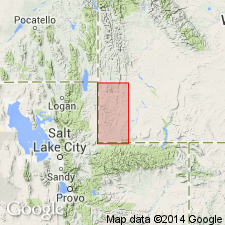
- Usage in publication:
-
- Beckwith formation*
- Modifications:
-
- Original reference
- Dominant lithology:
-
- Clay
- Sandstone
- Conglomerate
- AAPG geologic province:
-
- Green River basin
Summary:
Beckwith formation. Red, yellow, and reddish yellow shales and sandstones, at many places containing thick reddish conglomerate beds. Thickness 3,800 to 5,500 feet. Underlies Bear River formation, and overlies Twin Creek limestone. Jurassic fossils BELEMNITES DENSUS, TRIGONIA QUADRANGULARIS, and MYACITES (PLEUROMYA) WEBERENSIS from beds regarded as in lower part of formation identified by T.W. Stanton, USGS, see p. 57-58.
Named from extensive development on leased State lands now forming part of Beckwith Ranch [e.g., along South Fork Leeds Creek], situated just east of Beckwith Station on Oregon Short Line (see pl. 3, areal geol., scale 1:125,000). [Beckwith Station located in sec. 6, T. 22 N., R. 119 W., Beckwith 7.5-min quadrangle, Lincoln Co., southwestern WY.]
[GNC remark (ca. 1938, US geologic names lexicon, USGS Bull. 896): This name has been used in Idaho, in some old reports, but its use there is now discontinued, the rocks having been divided into several formations.]
Source: Publication; US geologic names lexicons (USGS Bull. 896, p. 36; USGS Bull. 1200, p. 265).
For more information, please contact Nancy Stamm, Geologic Names Committee Secretary.
Asterisk (*) indicates published by U.S. Geological Survey authors.
"No current usage" (†) implies that a name has been abandoned or has fallen into disuse. Former usage and, if known, replacement name given in parentheses ( ).
Slash (/) indicates name conflicts with nomenclatural guidelines (CSN, 1933; ACSN, 1961, 1970; NACSN, 1983, 2005, 2021). May be explained within brackets ([ ]).

